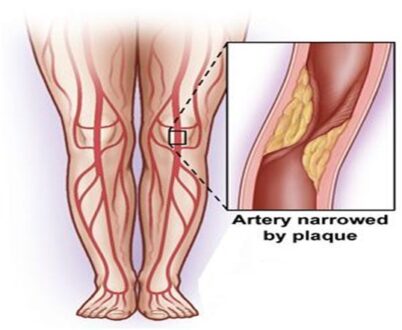Read about Intermittent Claudication Pain Treatment. The term claudication comes from the Latin claudicare meaning to limp. An aching, crampy, tired and sometimes burning pain in the legs that comes and goes that typically occurs with walking and goes away with restdue to poor circulation of blood in the arteries of the legs.
In very severe claudication the pain is also felt at rest. Intermittent claudication may occur in one or both legs and often continues to worsen over time. However, some people complain only of weakness in the legs when walking or a feeling of tiredness in the buttocks.
Intermittent Claudication Pain Treatment
Let’s review Intermittent Claudication Pain Treatment.
Causes of Intermittent Claudication
Several medical problems can cause claudication, but the most common is peripheral artery disease (PAD). Claudication is a symptom of PAD, which is caused by atherosclerosis. Other causes include:
- Spinal stenosis
- Tendinitis
- Aneurysm
- Stress fractures
- Arthritis
- Nerve damage in the legs (peripheral neuropathy) caused by diabetes or heavy
- use of alcohol
- A pulled muscle

Other conditions can also cut off blood flow to the leg and cause leg pain. But these are conditions that can happen suddenly. These include:
- A blood clot (thrombus) in the leg
- Swelling of muscle tissue that cuts off blood flow (compartment syndrome)
Risk factors of Intermittent Claudication
The main risk factors of Intermittent Claudication include:
- Smoking
- Diabetes
- Unhealthy cholesterol and lipid levels
- High blood pressure
- Advancing age
Symptoms of Intermittent Claudication
Following are the symptoms of Intermittent Claudication:
- Pain or discomfort in your feet, calves, thighs, hips or buttocks when exercising
- Intermittent pain that may come and go even with less-strenuous activities
- Pain at rest in legs even when sitting or lying down
- Discolored skin or ulcerations
- Sores on your lower legs, feet, toes, arms or fingers
- An aching or burning sensations
- Weakness
- Cold or numb feet and toes
- Poor balance when standing
- Drop in leg strength
- Sores that heal slowly
- Erectile dysfunction (impotence)
Intermittent Claudication Pain
The usually intermittent nature of the pain is due to narrowing of the arteries that supply the leg with blood, limiting the supply of oxygen to the leg muscles, a limitation that is felt especially when the oxygen requirement of these muscles rises with exercise.
The leg pain produced by claudication is commonly experienced as cramping in the thighs, calves, hips, and feet. The pain stops several minutes after the person rests, but returns when the person performs activities that use the leg muscles. If untreated, claudication is no longer intermittent and occurs when a person is resting.
The location of your pain depends upon the location of PAD. A person may have foot, calf, thigh or buttock pain, either alone or in combination. Calf claudication is the most frequent location of pain, and most commonly results from blockage of the superficial femoral artery in the mid-thigh. Foot claudication may occur from narrowing of an artery in the lower part of the leg (the tibial or peroneal artery).
Intermittent Claudication Treatment
Treatment of claudication and peripheral artery disease can help prevent your disease from getting worse and reduce your symptoms.
Life Style Modifications
Lifestyle changes that help you manage your leg artery disease include:
- Quitting smoking
- Maintaining your exercise program
- Managing diabetes by maintaining healthy blood sugar levels
- Lowering high cholesterol
- Lowering high blood pressure
- Eating foods low in saturated fats and calories
- Maintaining your ideal body weight
Exercise Therapy
Exercise therapy is the initial treatment for claudication.Therapeutic exercise recommendations for claudication generally consist of walking for periods of 1 hour or more, 3 or more times per week, for at least 3 to 6 months, ideally under medical supervision.
The aim is to increase the amount of time that you can walk without reproducing severe pain in your legs. You will gradually accomplish this by walking for longer and longer periods.
Avoid Certain Medications
Don’t use drugs that cause your blood vessels to constrict. Many sinus and cold medications sold over-the-counter contain pseudoephedrine, which is known to constrict blood vessels.
Diet Modification
Heart-healthy diet, low in saturated fat and sodium, to reduce unhealthy cholesterol levels and improve blood pressure.
Medications
There are a number of drugs on the market which claim to improve walking distance. These are not used by vascular surgeons, as the evidence for their effectiveness is very limited. There is evidence that taking Aspirin or Clopidogrel is generally good for people with circulation disorders (heart, brain and legs).
Surgery
If conservative therapy is inadequate, correction of the narrowing in the affected artery may be suggested. Procedures that are used to correct the narrowing of arteries include surgery (such as bypass grafting) and interventional radiology (such as balloon angioplasty). When claudication is severe and persistent, these procedures may be required to ultimately relieve the condition and the pain.
 Health & Care Information
Health & Care Information 

